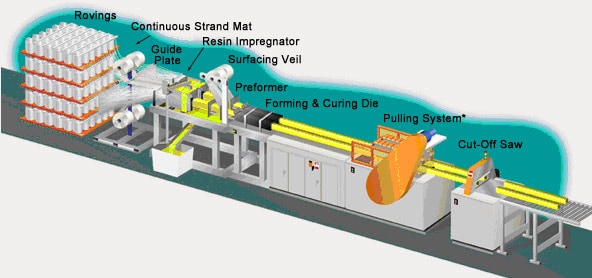Pultrusion is a manufacturing process for producing continuous lengths of FRP structural shapes.
Raw materials include a liquid resin mixture (containing resin, fillers and specialized additives) and reinforcing fibers. The process involves pulling these raw materials (rather than pushing as is the case in extrusion) through a heated steel forming die using a continuous pulling device. The reinforcement materials are in continuous forms such as rolls of fiberglass mat or doffs of fiberglass roving. As the reinforcements are saturated with the resin mixture (“wet-out”) in the resin impregnator and pulled through the die, the gelation (or hardening) of the resin is initiated by the heat from the die and a rigid, cured profile is formed that corresponds to the shape of the die.

While pultrusion machine design varies with part geometry, the basic pultrusion process concept is described in the following schematic.
The creels position the reinforcements for subsequent feeding into the guides. The reinforcement must be located properly within the composite and controlled by the reinforcement guides.
The resin impregnator saturates (wets out) the reinforcement with a solution containing the resin, fillers, pigment, and catalyst plus any other additives required. The interior of the resin impregnator is carefully designed to optimize the “wet-out” (complete saturation) of the reinforcements.
On exiting the resin impregnator, the reinforcements are organized and positioned for the eventual placement within the cross section form by the preformer. The preformer is an array of tooling which squeezes away excess resin as the product is moving forward and gently shapes the materials prior to entering the die. In the die the thermosetting reaction is heat activated (energy is primarily supplied electrically) and the composite is cured (hardened).
On exiting the die, the cured profile is pulled to the saw for cutting to length. It is necessary to cool the hot part before it is gripped by the pull block (made of durable urethane foam) to prevent cracking and/or deformation by the pull blocks. Two distinct pulling systems are used: a caterpillar counter-rotating type and a hand-over-hand reciprocating type.
In certain applications an RF (radio frequency wave generator) unit is used to preheat the composite before entering the die. When in use, the RF heater is positioned between the resin impregnator and the preformer. RF is generally only used with an all roving part.
